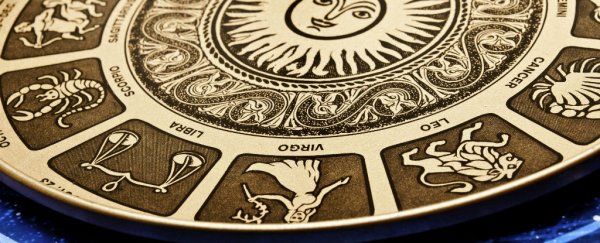If you just got an email from a friend wondering why NASA is telling them they're no longer a Scorpio, they're an Ophiuchus now, you're probably not the only one.
Last week, news spread that NASA had decided to update the astrological signs for the first time in 2,000 years, and people were freaking out that 86 percent of us now have a different star sign.
If your first response is "Who cares?" we're right there with you.
But there are a whole lot of people around the world who do take their star signs and horoscopes seriously, and with more than 25 percent of respondents in this recent survey calling astrology "very scientific", there's a big problem here.
Okay, so here's a bit of background first on wtf just happened.
There's an educational page for kids run by NASA called Space Place, and it discusses how, some 3,000 years ago, the ancient Babylonians were keen sky-watchers, and thought that the changing positions of constellations throughout the year could be linked to certain behaviours or events on Earth.
And so they invented the zodiac - the circle of 12 constellations based on the apparent path that the Sun takes across an imagined celestial sphere over the course of the year.
"So, as Earth orbits the Sun, the Sun would appear to pass through each of the 12 parts of the zodiac," Space Place explains. "Since the Babylonians already had a 12-month calendar (based on the phases of the Moon), each month got a slice of the zodiac all to itself."
But seeing as this happened 3,000 years ago, things were a bit arbitrary, and for whatever reason, the Babylonians left a constellation out of their zodiac - Ophiuchus.
"Even then, some of the chosen 12 didn't fit neatly into their assigned slice of the pie and slopped over into the next one," says Space Place.
"To make a tidy match with their 12-month calendar, the Babylonians ignored the fact that the Sun actually moves through 13 constellations, not 12."
Fast-forward to now, and NASA (and every non-NASA astronomer) notes that because of a tiny wobble in Earth's axis, the constellations are no longer in the same position in the sky as they were 3,000 years ago.
As Christopher Crockett explains for Earthsky.org, this wobble in the axis is super subtle - it takes 26,000 years to wobble around once - but the effects can build into something noticeable.
"On the June solstice 2,000 years ago, the Sun was sitting almost halfway between Gemini and Cancer," says Crockett. "On this year's June solstice, the Sun will be sitting between Gemini and Taurus. In the year 4609, the June solstice point will pass out of the constellation Taurus and into the constellation Aries."
Despite a massive clarification right at the top of NASA's Space Place page that "Astrology is not astronomy!" publications such as Cosmo, Yahoo News, and Marie Clare decided to publish a whole lot of new star sign dates, and the addition of a 13th zodiac sign, and attribute the changes to NASA:
Capricorn: Jan 20 - Feb 16
Aquarius: Feb 16 - March 11
Pisces: March 11 - April 18
Aries: April 18 - May 13
Taurus: May 13 - June 21
Gemini: June 21 - July 20
Cancer: July 20 - Aug 10
Leo: Aug 10 - Sept 16
Virgo: Sept 16 - Oct 30
Libra: Oct 30 - Nov 23
Scorpio: Nov 23 - Nov 29
Ophiuchus: Nov 29 - Dec 17
Sagittarius: Dec 17 - Jan 20
Except that NASA doesn't want any part in all that mess.
As NASA spokesperson Dwayne Brown told Ria Misra at Gizmodo:
"We didn't change any Zodiac signs, we just did the math. The Space Place article was about how astrology is not astronomy, how it was a relic of ancient history, and pointed out the science and math that did come from observations of the night sky."
So tell your friends that they can believe what they want when it comes to horoscopes and astrology, but please don't get NASA involved. It's too busy trying to figure out what's up with Pluto.
